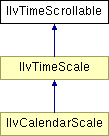
Rogue Wave Views 5.5.1
Rogue Wave Views
Foundation Package API Reference Guide
Rogue Wave Views
Documentation Home
 Rogue Wave Views 5.5.1 |
Rogue Wave Views |
Rogue Wave Views Documentation Home |
Date and time-related abstract class. More...
#include <ilviews/graphics/timescale.h>

Public Member Functions | |
| virtual IlDate | getMaxVisibleTime () const =0 |
| Returns the maximum time that the time scrollable can show. | |
| virtual IlDate | getMinVisibleTime () const =0 |
| Returns the minimum time that the time scrollable can show. | |
| virtual IlvDuration | getVisibleDuration () const =0 |
| Returns the duration of the time interval displayed by the time scrollable. | |
| virtual IlvTimeInterval | getVisibleInterval () const =0 |
| Returns the time interval displayed by the scale. | |
| virtual IlDate | getVisibleTime () const =0 |
| Returns the beginning of the time interval displayed by the time scrollable. | |
| virtual void | setMaxVisibleTime (IlDate d)=0 |
| Sets the maximum time that the time scrollable can show. | |
| virtual void | setMinVisibleTime (IlDate d)=0 |
| Sets the minimum time that the time scrollable can show. | |
| virtual void | setVisibleDuration (IlvDuration duration)=0 |
| Sets the duration of the time interval displayed by the time scrollable. | |
| virtual void | setVisibleInterval (IlDate time, IlvDuration duration)=0 |
| Sets the time interval displayed by the scale. | |
| virtual void | setVisibleTime (IlDate time)=0 |
| Sets the beginning of the time interval displayed by the time scrollable. | |
Date and time-related abstract class.
Library: views
This interface defines the behavior of a component whose time interval can be scrolled.
Time scrolling is constrained by the "minimum visible time" setMinVisibleTime and the "maximum visible time" setMaxVisibleTime. Both values must be valid.
There are four interrelated time properties: minVisibleTime, maxVisibleTime, visibleTime, and visibleDuration. These four values define two nested ranges like this:
minVisibleTime <= visibleTime <= visibleTime+visibleDuration <= maxVisibleTime
The time-scrollable component enforces this relationship by correcting or trimming properties according to the following rules:
The setMinVisibleTime and setMaxVisibleTime methods first validate that:
minVisibleTime <= maxVisibleTime
Next, the visible time and visible duration properties may be trimmed (in that order), to fit within the new min-max interval.
setVisibleTime and setVisibleDuration methods trim their argument to fit within the limits defined by the other three properties. The time-scrollable component should use the method IlvTimeScrollUtil::trimInterval to perform consistent validation and trimming of the time value arguments.
| virtual IlDate IlvTimeScrollable::getMaxVisibleTime | ( | ) | const [pure virtual] |
Returns the maximum time that the time scrollable can show.
setMaxVisibleTime Implemented in IlvTimeScale.
| virtual IlDate IlvTimeScrollable::getMinVisibleTime | ( | ) | const [pure virtual] |
Returns the minimum time that the time scrollable can show.
setMinVisibleTime Implemented in IlvTimeScale.
| virtual IlvDuration IlvTimeScrollable::getVisibleDuration | ( | ) | const [pure virtual] |
Returns the duration of the time interval displayed by the time scrollable.
setVisibleDuration Implemented in IlvTimeScale.
| virtual IlvTimeInterval IlvTimeScrollable::getVisibleInterval | ( | ) | const [pure virtual] |
Returns the time interval displayed by the scale.
setVisibleInterval Implemented in IlvTimeScale.
| virtual IlDate IlvTimeScrollable::getVisibleTime | ( | ) | const [pure virtual] |
Returns the beginning of the time interval displayed by the time scrollable.
setVisibleTime Implemented in IlvTimeScale.
| virtual void IlvTimeScrollable::setMaxVisibleTime | ( | IlDate | d | ) | [pure virtual] |
Sets the maximum time that the time scrollable can show.
The current visible time and duration are trimmed to fit the new min-max interval by calling the IlvTimeScrollUtil::trimInterval method.
| d | The maximum visible time. |
getMaxVisibleTime getVisibleDuration Implemented in IlvTimeScale.
| virtual void IlvTimeScrollable::setMinVisibleTime | ( | IlDate | d | ) | [pure virtual] |
Sets the minimum time that the time scrollable can show.
The current visible time and duration are trimmed to fit the new min-max interval by calling the IlvTimeScrollUtil::trimInterval method.
| d | The minimum visible time. |
getMinVisibleTime getVisibleDuration Implemented in IlvTimeScale.
| virtual void IlvTimeScrollable::setVisibleDuration | ( | IlvDuration | duration | ) | [pure virtual] |
Sets the duration of the time interval displayed by the time scrollable.
The specified duration is compared against the min and max visible times and is trimmed if necessary by calling the IlvTimeScrollUtil::trimInterval method. If you are changing both the visible time and duration, it is preferable to use the setVisibleInterval method instead.
| duration | The new duration value. |
Implemented in IlvCalendarScale, and IlvTimeScale.
| virtual void IlvTimeScrollable::setVisibleInterval | ( | IlDate | time, | |
| IlvDuration | duration | |||
| ) | [pure virtual] |
Sets the time interval displayed by the scale.
The specified duration is compared against the min and max visible times and is trimmed if necessary by calling the IlvTimeScrollUtil::trimInterval method.
| time | The new time value. | |
| duration | The new duration value. |
getMinVisibleTime getMaxVisibleTime Implemented in IlvCalendarScale, and IlvTimeScale.
| virtual void IlvTimeScrollable::setVisibleTime | ( | IlDate | time | ) | [pure virtual] |
Sets the beginning of the time interval displayed by the time scrollable.
The specified time value is compared against the min and max visible times and is trimmed if necessary by calling the IlvTimeScrollUtil::trimInterval method. If you are changing both the visible time and duration, it is preferable to use the setVisibleInterval method instead.
| time | The new time value. |
Implemented in IlvTimeScale.
© Copyright 2012, Rogue Wave Software, Inc. All Rights Reserved.
Rogue Wave is a registered trademark of Rogue Wave Software, Inc. in the United States and other countries. All other trademarks are the property of their respective owners.